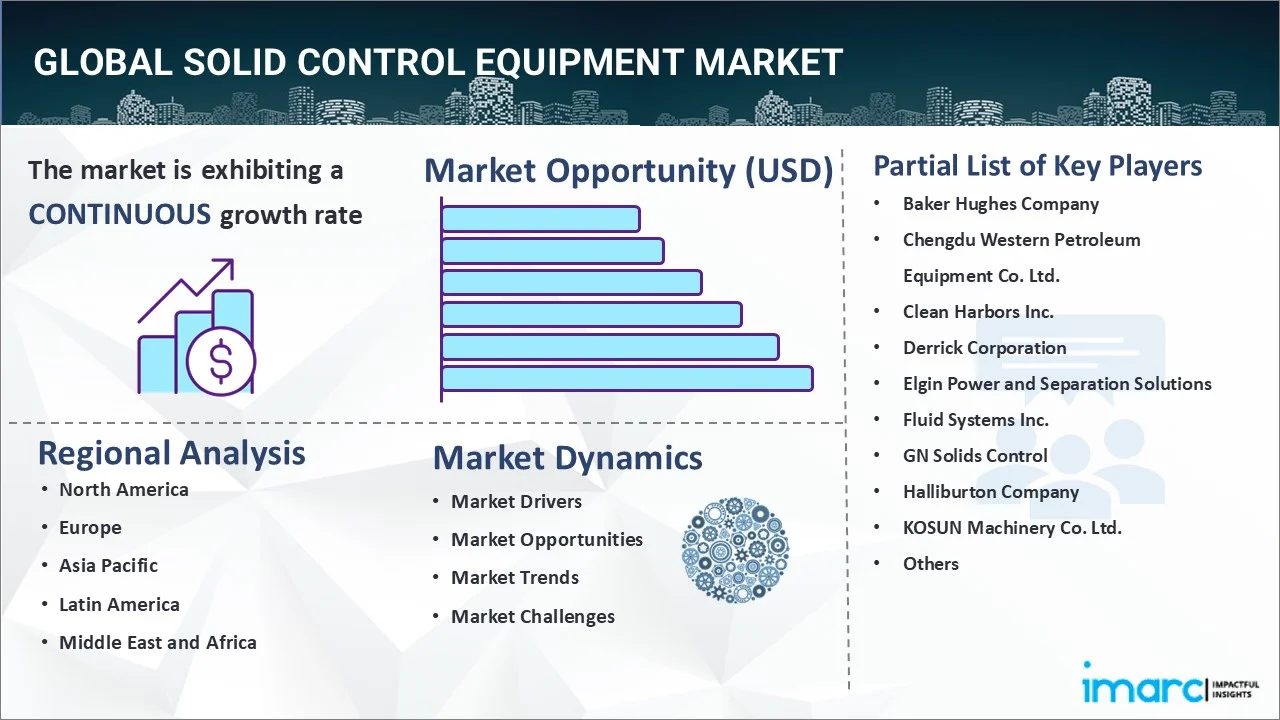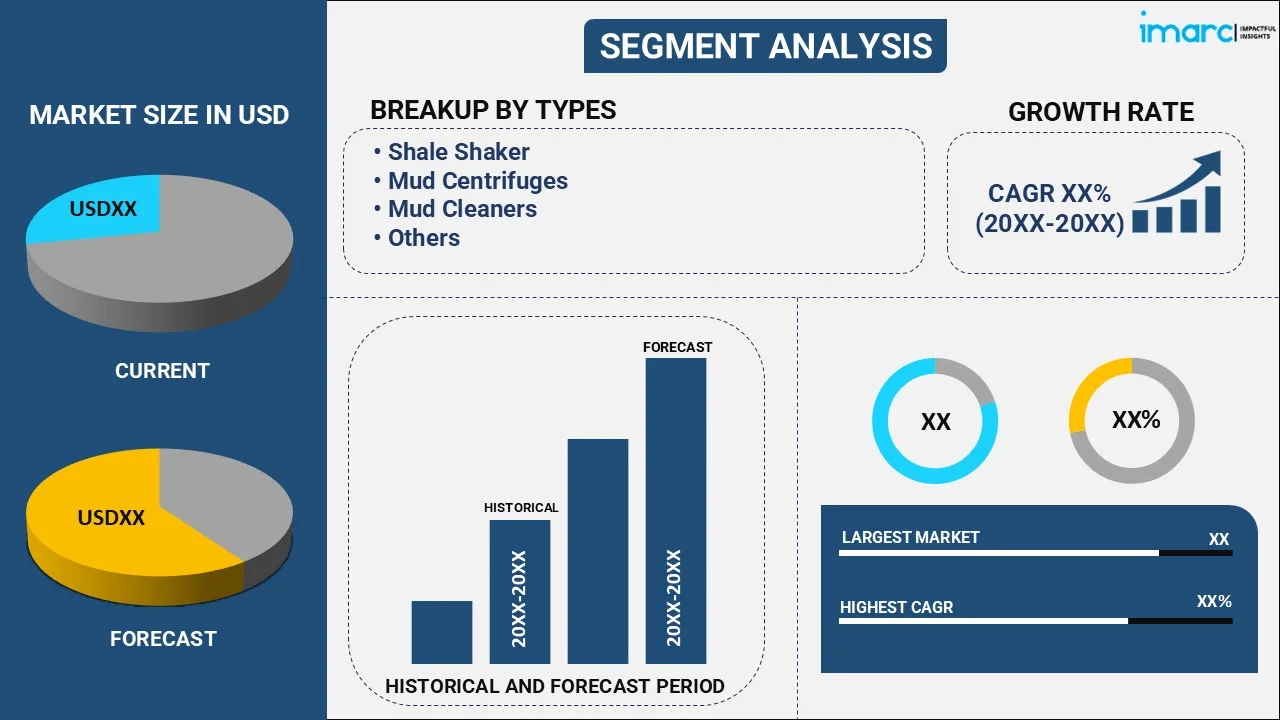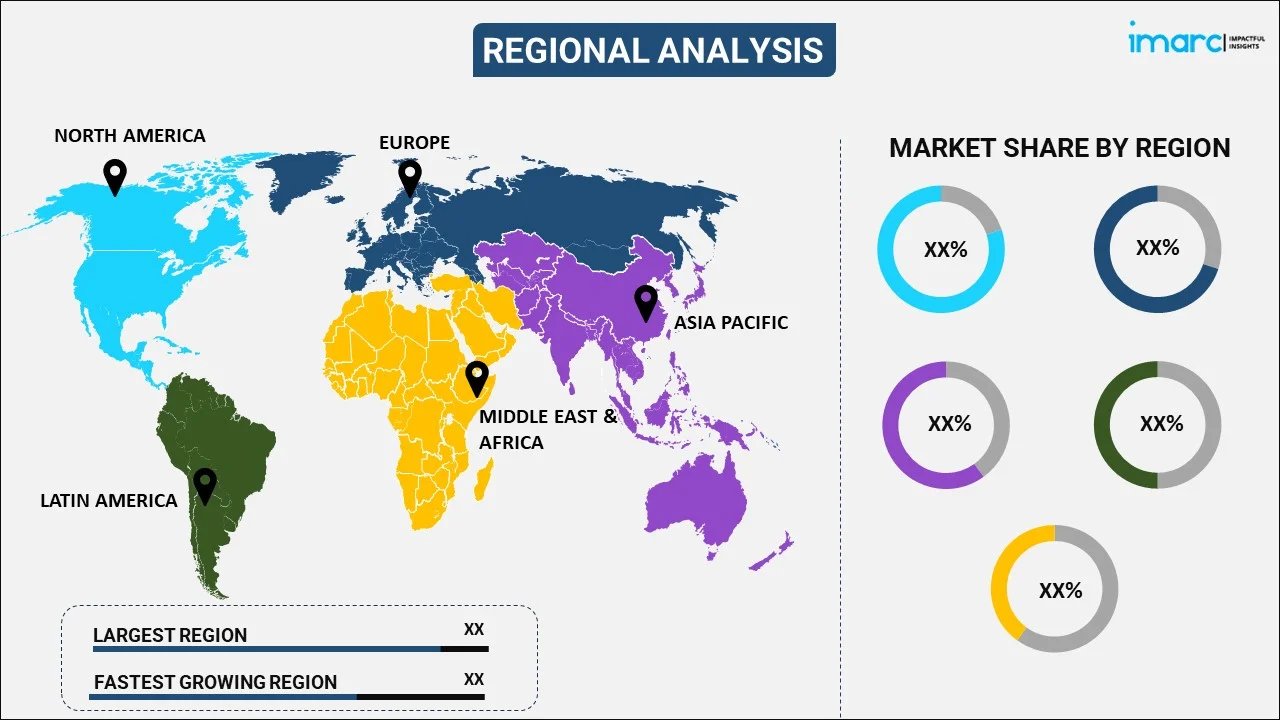
Solid Control Equipment Market Report by Type (Shale Shaker, Mud Centrifuges, Mud Cleaners, Desander and Desilter, and Others), End Use (Oil and Gas, Construction and Infrastructure, Mining, and Others), and Region 2025-2033
Market Overview:
The global solid control equipment market size reached USD 3.8 Billion in 2024. Looking forward, IMARC Group expects the market to reach USD 7.9 Billion by 2033, exhibiting a growth rate (CAGR) of 7.61% during 2025-2033. The rising shift towards unconventional drilling techniques, such as horizontal drilling and hydraulic fracturing, the growing preference for unconventional drilling, and the accelerating focus on improving operational efficiency to reduce costs are some of the major factors propelling the market.
|
Report Attribute
|
Key Statistics
|
|---|---|
|
Base Year
|
2024 |
|
Forecast Years
|
2025-2033
|
|
Historical Years
|
2019-2024
|
| Market Size in 2024 | USD 3.8 Billion |
| Market Forecast in 2033 | USD 7.9 Billion |
| Market Growth Rate 2025-2033 | 7.61% |
Solid control equipment is an essential part of the drilling process used in the oil and gas industry. It is designed to manage and separate solids from drilling fluids, helping to maintain the integrity of the drilling system. This equipment plays a critical role in preventing the erosion of drilling tools and equipment by removing abrasive particles. It consists of a series of devices such as shale shakers, desilters, and desanders, which filter and segregate the unwanted solids from the liquid. By controlling the solid particles in the drilling fluid, Solid Control Equipment not only enhances efficiency but also minimizes environmental impact by reducing waste. Its use ensures the smooth operation of drilling activities, contributing to cost savings and the overall success of the drilling project. Overall, solid control equipment is a vital component in maintaining the optimal condition of the drilling fluids, ensuring both operational excellence and environmental compliance.

The industry's move towards unconventional drilling techniques, such as horizontal drilling and hydraulic fracturing has created a need for more specialized solid control equipment. These complex methods require advanced tools to effectively manage solids and maintain the integrity of drilling fluids. Therefore, the growing preference for unconventional drilling highlights the importance of effective solid control, further driving the market growth. Along with this, the solid control equipment industry is also closely linked to global economic growth and infrastructure development. As economies expand, the demand for energy resources, particularly oil and gas, rises correspondingly. This trigger increased exploration and production activities, further necessitating the use of equipment. With increasing competition in the oil and gas sector, companies are focusing on improving operational efficiency to reduce costs. Solid control equipment plays a critical role in enhancing efficiency by minimizing wear and tear on drilling components, reducing downtime, and ensuring optimal performance. The drive towards leaner and more efficient operations has made investment in quality solid control equipment a priority for many organizations. Apart from this, the widespread applications in various other industries, including mining and construction are contributing to the market. Moreover, the emerging trend towards customization is creating a positive market outlook.
Solid Control Equipment Market Trends/Drivers:
Increased Demand in Oil and Gas Exploration
The growing demand for energy worldwide has led to a rise in oil and gas exploration and production activities. Countries are investing in offshore and onshore drilling projects to tap into unexplored reserves. Solid control equipment plays a vital role in these activities by ensuring the efficiency and integrity of drilling operations. Its ability to filter and separate solids from drilling fluids minimizes the erosion of essential tools and equipment. Furthermore, the need to comply with stringent environmental regulations is promoting the use of high-quality equipment that reduces waste and pollution. Investments in research and development to create more advanced and environmentally friendly equipment are also driving this market, as companies seek to align with sustainability goals and reduce operational costs.
Technological Advancements in Solid Control Systems
The emergence of cutting-edge technologies has significantly influenced the Solid Control Equipment industry. Along with this, innovations such as real-time monitoring systems, automation, and the integration of artificial intelligence are transforming the way these tools operate. These advancements increase the efficiency of solid control and enhance safety and accuracy in the drilling process. Thus, this is significantly supporting the market. In addition, the incorporation of these modern technologies also enables the industry to meet the specific demands of various drilling environments, whether offshore or onshore. As companies continue to adopt these advanced systems, the market for Solid Control Equipment is likely to witness robust growth.
Stringent Environmental Regulations and Compliance Standards
Governments and international organizations are imposing strict environmental regulations related to drilling activities to protect natural ecosystems. These regulations require the proper management of drilling waste, including solid control. In confluence with this, compliance with these standards necessitates the use of advanced solid control equipment, capable of minimizing waste and environmental harm. Apart from this, the escalating need to adhere to these regulations pushes companies in the oil and gas sector to invest in high-quality and efficient solid control equipment. This trend reflects a broader global movement towards sustainability and environmental protection, fostering growth in this market segment.
Solid Control Equipment Industry Segmentation:
IMARC Group provides an analysis of the key trends in each segment of the global solid control equipment market report, along with forecasts at the global, regional, and country levels from 2025-2033. Our report has categorized the market based on type, and end use.
Breakup by Type:

- Shale Shaker
- Mud Centrifuges
- Mud Cleaners
- Desander and Desilter
- Others
Mud centrifuges dominates the market
The report has provided a detailed breakup and analysis of the market based on the type. This includes shale shaker, mud centrifuges, mud cleaners, desander and desilter, and others. According to the report, mud centrifuges represented the largest segment.
The market drivers propelling the prominence of shale shaker types within the solid control equipment industry are pivotal to its evolution. With a heightened emphasis on environmental sustainability, the efficient separation of solids from drilling fluids achieved by shale shakers has garnered substantial attention. This proves crucial in mitigating ecological impacts and enhancing drilling efficacy. As global demands for energy persist, particularly in oil and gas exploration, the demand for adept solid control equipment, including shale shakers, continues to rise. Additionally, ongoing technological advancements are refining shaker efficiency and longevity, bolstering their adoption.
On the other hand, the escalating focus on environmental stewardship has spotlighted the efficacy of mud centrifuges in separating fine solids from drilling fluids, curbing ecological impact and refining drilling operations. As global energy demands persist, particularly in the realm of oil and gas exploration, the need for proficient solid control equipment, including mud centrifuges, remains robust. Technological strides geared toward enhancing centrifuge performance and durability further bolster their adoption. In this landscape, the solid control equipment sector is experiencing notable growth, fueled by the indispensable role mud centrifuges play in optimizing drilling processes, thus reshaping the industry's competitive landscape.
Breakup by End Use:
- Oil and Gas
- Construction and Infrastructure
- Mining
- Others
A detailed breakup and analysis of the market based on the end use has also been provided in the report. This includes oil and gas, construction and infrastructure, mining, and others.
Market drivers influencing the oil and gas end use segment within the solid control equipment industry are pivotal to its progression. The steadfast global demand for energy, prominently from oil and gas sources, underscores the essential role of efficient solid control equipment. As extraction and exploration activities rise, the need to optimize drilling operations while mitigating environmental impact intensifies. Solid control equipment, with its capacity to separate solids from drilling fluids, not only enhances operational efficiency but also aligns with sustainable practices. Technological innovations geared toward refining equipment performance and reducing downtime further amplify its adoption.
On the contrary, the construction sector's reliance on drilling activities for foundation work and utility installations underscores the significance of equipment that can effectively separate solids from drilling fluids. This not only optimizes construction processes but also minimizes environmental impact. Technological advancements aimed at enhancing equipment efficiency and durability further drive its adoption. In this context, the solid control equipment sector is experiencing notable growth, as the industry embraces innovative solutions to streamline construction and infrastructure projects while adhering to sustainability principles.
Breakup by Region:

- North America
- United States
- Canada
- Europe
- Germany
- France
- United Kingdom
- Italy
- Spain
- Others
- Asia Pacific
- China
- Japan
- India
- South Korea
- Australia
- Indonesia
- Others
- Latin America
- Brazil
- Mexico
- Others
- Middle East and Africa
North America exhibits a clear dominance, accounting for the largest the solid control equipment market share
The report has also provided a comprehensive analysis of all the major regional markets, which include North America (the United States and Canada); Europe (Germany, France, the United Kingdom, Italy, Spain, and others); Asia Pacific (China, Japan, India, South Korea, Australia, Indonesia, and others); Latin America (Brazil, Mexico, and others); and the Middle East and Africa. According to the report, North America represented the largest share.
Market drivers exerting influence on the solid control equipment industry in North America are instrumental in shaping its trajectory. The region's robust energy sector, marked by significant oil and gas exploration activities, generates a substantial demand for efficient solid control equipment. As environmental regulations become more stringent, the industry seeks solutions that can effectively separate solids from drilling fluids, optimizing operations while adhering to sustainability standards. Additionally, the ongoing advancements in technology, enhancing the performance and durability of solid control equipment, fuel its adoption. North America's continuous investment in energy infrastructure and construction projects further propels the demand for such equipment.
On the contrary, Asia Pacific’s rapid industrialization and urbanization, and infrastructural development drive the demand for efficient solid control equipment. As the energy and construction sectors expand, particularly in emerging economies, the need to enhance drilling operations by effectively separating solids from drilling fluids becomes paramount. Stringent environmental regulations amplify the importance of sustainable practices, aligning with the industry's focus on minimizing ecological impact. Technological innovations that improve the performance and longevity of solid control equipment further contribute to its adoption.
Competitive Landscape:
The market is experiencing significant growth due to the utilization of various strategies to meet industry demands and position themselves as leaders in the field. These strategies encompass technological advancements, product innovation, strategic partnerships, and global expansion. Along with this, companies are investing in research and development to enhance equipment efficiency, durability, and environmental sustainability. Innovations such as advanced centrifuge designs, automated control systems, and IoT integration are being introduced to streamline operations and reduce downtime. Additionally, manufacturers are collaborating with energy and construction firms to tailor solutions to their specific needs, fostering long-term partnerships. Geographic expansion into emerging markets, especially in Asia Pacific and the Middle East, is a common approach to tap into growing demand. Furthermore, many companies are emphasizing their commitment to environmental responsibility by developing equipment that adheres to stringent regulations and promotes resource efficiency.
The report has provided a comprehensive analysis of the competitive landscape in the market. Detailed profiles of all major companies have also been provided. Some of the key players in the market include:
- Baker Hughes Company
- Chengdu Western Petroleum Equipment Co. Ltd.
- Clean Harbors Inc.
- Derrick Corporation
- Elgin Power and Separation Solutions
- Fluid Systems Inc.
- GN Solids Control
- Halliburton Company
- KOSUN Machinery Co. Ltd.
- NOV Inc.
- SLB
Solid Control Equipment Market Report Scope:
| Report Features | Details |
|---|---|
| Base Year of the Analysis | 2024 |
| Historical Period | 2019-2024 |
| Forecast Period | 2025-2033 |
| Units | Billion USD |
| Scope of the Report | Exploration of Historical and Forecast Trends, Industry Catalysts and Challenges, Segment-Wise Historical and Predictive Market Assessment:
|
| Types Covered | Shale Shaker, Mud Centrifuges, Mud Cleaners, Desander and Desilter, Others |
| End Uses Covered | Oil and Gas, Construction and Infrastructure, Mining, Others |
| Regions Covered | North America, Europe, Asia Pacific, Latin America, Middle East and Africa |
| Countries Covered | United States, Canada, Germany, France, United Kingdom, Italy, Spain, China, Japan, India, South Korea, Australia, Indonesia, Brazil, Mexico |
| Companies Covered | Baker Hughes Company, Chengdu Western Petroleum Equipment Co. Ltd., Clean Harbors Inc., Derrick Corporation, Elgin Power and Separation Solutions, Fluid Systems Inc., GN Solids Control, Halliburton Company, KOSUN Machinery Co. Ltd., NOV Inc., SLB, etc. |
| Customization Scope | 10% Free Customization |
| Post-Sale Analyst Support | 10-12 Weeks |
| Delivery Format | PDF and Excel through Email (We can also provide the editable version of the report in PPT/Word format on special request) |
Key Questions Answered in This Report:
- How has the global solid control equipment market performed so far, and how will it perform in the coming years?
- What are the drivers, restraints, and opportunities in the global solid control equipment market?
- What is the impact of each driver, restraint, and opportunity on the global solid control equipment market?
- What are the key regional markets?
- Which countries represent the most attractive solid control equipment market?
- What is the breakup of the market based on the type?
- Which is the most attractive type in the solid control equipment market?
- What is the breakup of the market based on the end use?
- Which is the most attractive end use in the solid control equipment market?
- What is the competitive structure of the global solid control equipment market?
- Who are the key players/companies in the global solid control equipment market?
Key Benefits for Stakeholders:
- IMARC’s report offers a comprehensive quantitative analysis of various market segments, historical and current market trends, market forecasts, and dynamics of the solid control equipment market from 2019-2033.
- The research study provides the latest information on the market drivers, challenges, and opportunities in the global solid control equipment market.
- The study maps the leading, as well as the fastest-growing, regional markets. It further enables stakeholders to identify the key country-level markets within each region.
- Porter's five forces analysis assist stakeholders in assessing the impact of new entrants, competitive rivalry, supplier power, buyer power, and the threat of substitution. It helps stakeholders to analyze the level of competition within the solid control equipment industry and its attractiveness.
- Competitive landscape allows stakeholders to understand their competitive environment and provides an insight into the current positions of key players in the market.
Need more help?
- Speak to our experienced analysts for insights on the current market scenarios.
- Include additional segments and countries to customize the report as per your requirement.
- Gain an unparalleled competitive advantage in your domain by understanding how to utilize the report and positively impacting your operations and revenue.
- For further assistance, please connect with our analysts.
 Inquire Before Buying
Inquire Before Buying
 Speak to an Analyst
Speak to an Analyst
 Request Brochure
Request Brochure
 Request Customization
Request Customization




.webp)




.webp)












